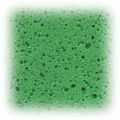Sponge (material)
|
|
A sponge is a tool or cleaning aid consisting of porous material. Sponges are usually used for cleaning impervious surfaces. They are especially good at absorbing water and water-based solutions.
Sponges are commonly made from cellulose wood fibers or foamed plastic polymers. Some natural sponges are still sold, but most are now used either as body or facial sponges (bath sponges) or as tools for sponge painting.
The three other categories of available synthetic sponges are: low-density polyether (known as the rainbow packs of non-absorbent sponges), PVA (very dense, highly absorbent material with no visible pores), and polyester.
Polyester sponges are subdivided into a variety of types, some of which are reticulated (artificially broken-in) for ease of use. One type, double-blown polyester, has high water-retention ability approaching or equaling that of PVA sponges, but with visible pores and more diverse uses.
Harboring bacteria

Because it is made primarily made of wood fiber, a cellulose sponge can be a medium for the growth of harmful bacteria or fungi, especially when it is allowed to remain wet between uses. Research at the University of Florida has found that if a wet sponge is heated in a microwave oven for two minutes most bacteria will be killed.[citation needed]
Gallery
-

Natural sponges for sale in Crete
-

Luffa aegyptiaca sponge section magnified 100 times
-

Close-up
-
Souvenir made of artificial sponge
-

Aspect
See also
References
External links
![]() Media related to Cleaning sponges at Wikimedia Commons
Media related to Cleaning sponges at Wikimedia Commons
| ||||||||
.jpg)


